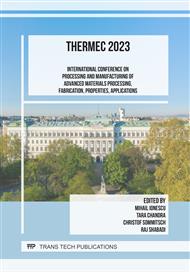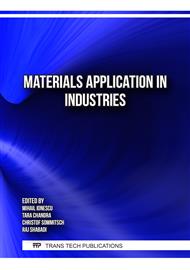[1]
M. Saini, Y. Singh, P. Arora, V. Arora, K. Jain, World Journal of Clinical Cases: WJCC 3 (2015) 52.
Google Scholar
[2]
M. Long, H. Rack, Biomaterials 19 (1998) 1621-1639.
Google Scholar
[3]
K. Miura, N. Yamada, S. Hanada, T.-K. Jung, E. Itoi, Acta biomaterialia 7 (2011) 2320-2326.
Google Scholar
[4]
J.D.C. Tardelli, C. Bolfarini, A.C. Dos Reis, Journal of Trace Elements in Medicine and Biology 62 (2020) 126618.
DOI: 10.1016/j.jtemb.2020.126618
Google Scholar
[5]
S.S. Sidhu, H. Singh, M.A.-H. Gepreel, Materials Science and Engineering: C 121 (2021) 111661.
Google Scholar
[6]
M. Niinomi, Materials Science and Engineering: A 243 (1998) 231-236.
Google Scholar
[7]
K.S. Tun, M. Gupta, T. Srivatsan, Processing challenges and properties of lightweight high entropy alloys, High Entropy Alloys, CRC Press, 2020, pp.95-124.
DOI: 10.1201/9780367374426-4
Google Scholar
[8]
J.W. Yeh, Y.L. Chen, S.J. Lin, S.K. Chen, High-entropy alloys–a new era of exploitation, Materials science forum, vol 560, Trans Tech Publ, 2007, pp.1-9.
DOI: 10.4028/www.scientific.net/msf.560.1
Google Scholar
[9]
K.-K. Wong, H.-C. Hsu, S.-C. Wu, W.-F. Ho, Journal of Alloys and Compounds 868 (2021) 159137.
Google Scholar
[10]
S. Hu, T. Li, Z. Su, D. Liu, Intermetallics 140 (2022) 107401.
Google Scholar
[11]
M. Abdel-Hady, K. Hinoshita, H. Fuwa, Y. Murata, M. Morinaga, Materials Science and Engineering: A 480 (2008) 167-174.
DOI: 10.1016/j.msea.2007.06.083
Google Scholar
[12]
L. Zhuang, E. Langer, Journal of materials science 24 (1989) 381-388.
Google Scholar
[13]
M. Abdel-Hady, H. Fuwa, K. Hinoshita, H. Kimura, Y. Shinzato, M. Morinaga, Scripta Materialia 57 (2007) 1000-1003.
DOI: 10.1016/j.scriptamat.2007.08.003
Google Scholar
[14]
P. Ji, B. Chen, B. Li, Y. Tang, G. Zhang, X. Zhang, M. Ma, R. Liu, Journal of Materials Science & Technology 69 (2021) 7-14.
Google Scholar
[15]
M. Niinomi, M. Nakai, International journal of biomaterials 2011 (2011).
Google Scholar



